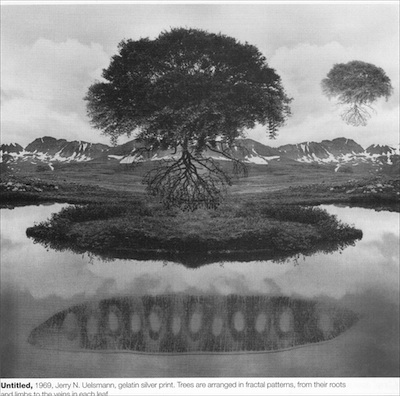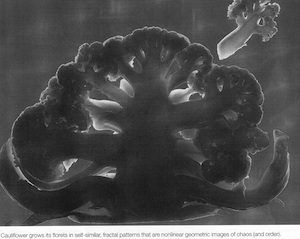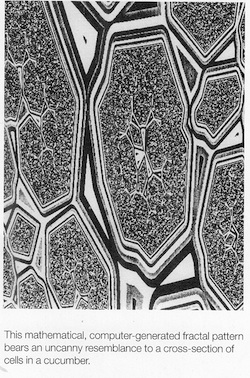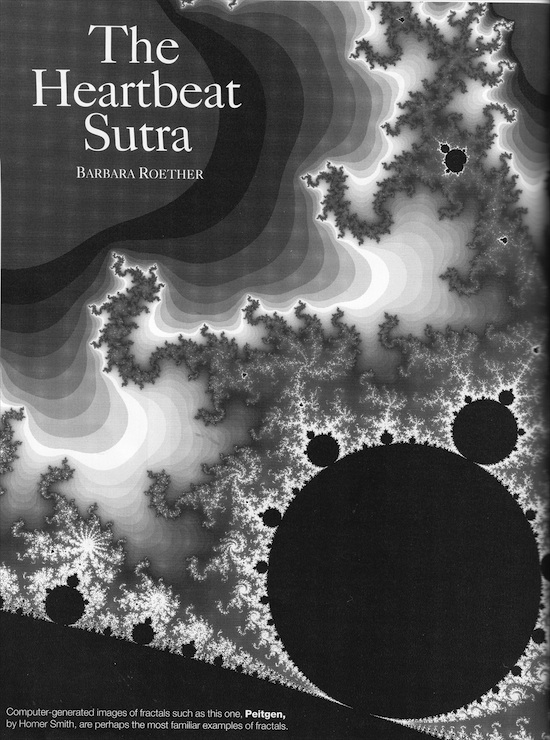The first time I talked with “Dr. Chaos” about Buddhism was one twilit night a couple of years ago in a California January. We were sitting on the deck of a friend’s house in Big Sur, two hundred feet above the Pacific. It’s a place where you can both hear and see the waves break. As we listened and watched, the water stretching out like a vast mirror to the horizon, there, in glorious magenta light, the winter sun slowly set: metallic, then amber, then scarlet—one of those natural scenes so far beyond the viewer, so much grander and deeper, that a kind of vertigo swept over us.
“You know, I have never watched a sunset before in my life, not to that final moment,” said Dr. Chaos as the darkness rose up out of the ocean and covered us.
“Why not?” I asked, shocked that anyone could have missed that for fifty years. Certainly even an ensconced physicist from Stanford University and Lawrence Livermore Lab must have come away from the computer long enough to stumble on a sunset now and again.
“Because it would make me too lonely,” he replied. “I couldn’t watch it alone, it would be too overwhelming.”
Then somehow I understood something new about Minh Duong-Van’s work on “controlling chaos.” For him, the natural world of phenomena would be too unpredictable to face head-on—all those unleashed floods of passionate color bleeding extravagantly across the sky. As we talked, it occurred to me that of course such a man would find his happiness in mathematical order: unable to contain his own emotions, he would strive—and flourish—in the world of theory.
Minh Duong-Van was born in a village in Vietnam sometime around 1940. He doesn’t know his birthday. His father worked as a janitor at a Jesuit school, and when he couldn’t work one day Minh took his place. The Jesuits befriended the boy who had a knack for math and sent him to France to be educated. He returned to Vietnam briefly, then found his way to Cornell, then Stanford, then to Lawrence Livermore Lab. He was among the first Vietnamese to receive a Ph.D. in the United States. His academic specialty is chaos theory and, specifically, “controlling chaos.” In fact, his reputation rests with his experiments in controlling chaos in lasers. For the last few years, however, he has been applying his ideas to heart defibrillation.
The science of chaos began in the 1970s in Santa Cruz, California, and quickly spread through the scientific community. Today there are around 20,000 “practitioners.” It is a branch of physics that concerns itself generally with disorder in systems, with fluctuations, irregularities, and anomalies. It is concerned with observing patterns, periodicities, and nonlinear equations. Many people are familiar with the startling shapes and patterns of fractals, the nonlinear geometric images of chaos (and order). As James Gleick says in his popular book on the subject, Chaos: Making a New Science, “Where chaos begins, classical science stops.”
Anyone who has ever approached the Tibetan practice of shi-ne (or samatha) meditation will be familiar with the idea of “controlling chaos.” Remembering metaphors that various teachers had used for the mind in its everyday state—turbulent, out of control, chaotic—I told Minh that controlling chaos sounded like a title for a weekend meditation intensive at Esalen. “It should be,” he said.
I thought of other Buddhist descriptions of the world, and Minh, as he sat next to me in the dark that night, talked of chaos.
Central to both chaos theory and Buddhism is the practice of working from the inside out, of beginning with “the projector not the projected.” In both Vajrayana Buddhism and chaos theory, the material at hand is used for transformation: fierce deities are employed to dispel negativity, or irregular signals to the heart are used to cure irregular heartbeats. Both disciplines view systems as open and susceptible to change at any point; both are about process, rather than object. Chaos theory is referred to as “a science of process,” and Buddhist meditation as “a practice.”
Similarities of description can be found in concepts ranging from the simplest principles of meditation to the possibility of mathematical equations for karma. Notions of emptiness from the second-century Buddhist philosopher Nagarjuna’s teachings have much in common with the antimatter of “universal fluctuation.”
In Path to the Middle, Kensur Yeshey Thupden says, “Scientists today understand ‘dependent arising’ well; they can identify what comes from which causes. . . . Their expertise [however] lies with the temporary immediate causes, not with the more distant (and deeper) causes of things.” Indeed, in light of the new thinking on chaos, such an understanding may soon be outdated.
Much of chaos theory starts with what is known as a nonlinear equation. The nonlinear equation was first explained by another man who, like Minh and I, got an idea from watching the weather. In 1961, Edward Lorenz, a meteorologist, was feeding a series of numbers representing weather patterns into a computer. One day, in a hurry to go out to lunch, he punched in the usual numbers but skipped a few decimal places, assuming that such minute differences could not affect the larger numbers—those representing cumulous clouds and trade winds—that stood to the left of the decimal. He was shocked to find on his return that his calculations had gone haywire: large chaotic fluctuations appeared in what had been regular patterns. In other words, the changes were not in direct proportion to the cause; the relationship between cause and effect was nonlinear.
Officially, chaos scientists call that scenario “sensitivity to initial conditions”—a microscopic variation that (in certain systems) has profound effects on a macroscopic level. Minh even goes so far as to insist that this “sensitivity to initial conditions” is what Buddhists call karma—the initial predispositions that have been created in the past and continue to unfold in the present.

The force that we are so initially sensitive to is “fluctuation,” and Minh uses another example to illustrate it: “A widely accepted notion is that when you flip a penny there is a fifty-fifty chance of its being heads or tails. That’s the notion we base our thinking on. But what actually happens is much different. Say you toss it one hundred times; as the penny keeps shifting from heads to tails, the actual numbers always hover slightly above or below 50 percent, so you have a stream of numbers: 50.002, 49.005, and so on. Flip for another hour and you find that the numbers hover around this equilibrium indefinitely, always edging slightly to one side or the other. Contrary to all our theoretical expectations, fifty-fifty is something that never actually occurs.”
It’s a plausible explanation of karma: the hidden fluctuations that toss us this side or that side of even, the hidden quotient in all our actions, the irregularity of each day. One could imagine our lives, like the coins, progressing toward some equilibrium, but dancing endlessly from this side to that.
Minh adds that it is critical to remember that “the outcome of an action depends on the nature of the action.” In the penny drop, a slight angle of the hand, or the most subtle air current will control how the coin falls. Therefore, the outcome is linked to the action that produced it.
The hand that drops the coin is what a Buddhist might call intention. The importance of intention in determining the karmic effect of an action is well known. Kalu Rinpoche writes, “Mental attitude is the most crucial factor in any situation,” and “through changing our attitude we change our experience.”
Minh believes it is not simply that the fluctuation causes various results when the coin drops, but that a new pattern is created. Things are changed on a profound level and may never return to the pattern they were in before.
This breaking of “habitual patterns” is a familiar Buddhist idea. When the habitual pattern can be broken, interrupted even only slightly, a kind of openness arises that short-circuits the usual patterns of behavior. From a Buddhist view, the result of these pattern changes could affect what realm one might be born into.
I once heard a story that the reason the late Dilgo Kyentse Rinpoche limped so severely was that when he was a boy, he once carelessly stepped over a dharma text. The unique lesson of chaos is that these decisive steps are happening all the time. Any moment is one that can have incredible consequences. A small pressure applied at the right moment to a sad friend’s hand makes all the difference, while the same small pressure, applied a moment later, makes no difference at all. The same principle applies to heart fibrillation; it’s not only the amount of “zap,” sent to the ailing heart that is important, but when it is sent. Timing is crucial.
Minh says, “This life is not a direct cause-and-effect equation—that would be a linear equation. That’s why I like Buddhism, it’s nonlinear. Mathematicians hate nonlinear equations because they are so difficult to solve. Christianity is linear, deterministic. Science grew up in that mind. But nonlinearity, now that’s workable.”
I ask Minh, “Could you construct karma in mathematical equations?” “Certainly,” he says. “I think so. Maybe.”
“It is easy to predict the trajectory of a tennis ball through air, but very difficult to predict the behavior of a grain of pollen falling through the water of a pond. With a grain of pollen—and with a person—Newtonian physics flies out the window, and nonlinearity flies in.”
According to Minh’s view, the probability of understanding your karma will vary with the nature of your karma. It will be harder or easier to change your behavior, depending on that behavior itself. In chaotic systems (like samsara), order can often be introduced through feedback. Minh explains how it works.
“Imagine you are in a helicopter over the Mojave Desert, watching a jeep moving on a rough dirt road on a barren plateau. The jeep is veering very sharply to one side, then another, slowing down almost to a complete stop and then speeding up past ninety. At times the wheels creep dangerously close to a sharp gully. From a helicopter we assume that there are problems with the terrain—there must be rocks and holes in the road we simply cannot see from so far above. This is how conventional science still operates, assuming that if we could only get a closer look we could see all the causes.
“But chaos theory tell us that the real reason for such erratic driving is that the man found out the night before that his wife is having an affair. He is incredibly angry, slightly hungover, and his mind is full of conflicting chaotic images. So you need to fix his state of mind, not the road. But maybe you don’t even need to fix that because this situation has gotten so chaotic that it is about to get orderly on its own.
“This is where the notion of feedback comes in. In this situation, the fact that this man keeps almost driving into the gully, the way he almost swerves off the road into those cactuses, will change his mind. The danger he is causing himself will ‘feed back’ to his anger, and subdue it. He will realize that his anger is about to kill him, and he will calm down a little, so he doesn’t drive off the road, because he doesn’t actually want to die over this woman. It changes what I call the ‘parameter space’ which in this case is his state of mind.”

From time to time, I talk to Minh late at night. He sleeps sitting up in a futon chair in a modern studio apartment in Palo Alto; he hates the dark and hates to be alone, which is why he lives in apartments where he can hear the presence of others. In the meantime, he is looking for a wife who will be there all the time but not ever really be there: a typical prescription for a man who has, by his own admission, “been chasing fluctuations [his] entire life.” But the point is, he imagines his life as a continuing meditation.
“I’m meditating all the time,” says Minh, “but I meditate not with quiet, but with more noise. I go to Las Vegas and play the slot machines. That’s how I meditate.”
In The Dawn of Tantra, I happened on the following response Trungpa Rinpoche gave to a question about the complexities and confusions in everyday life:
Q.: The more confusion, the more unity?
Trungpa Rinpoche: That’s what tantric people say.
Q.: You mean the more confusion there is, the more difficult it is to stamp a system on reality?
Trungpa Rinpoche: Chaos has an order by virtue of which it isn’t really chaos. But when there’s no chaos, no confusion, there is luxury, comfort. Comfort and luxury lead you more into samsara, creating more luxurious situations adds further to your collection of chaos. All these luxurious conclusions come back on you and you begin to question them, which leads you to the further understanding that, after all, this discomfort has order in it.
Maybe Minh had a point in all his disorder: “I have never done the kind of meditation you talk of, but I understand it. Truly I think that the underlying fluctuation of the universe is lurking in meditation. When someone meditates very well, they can sense the underlying fluctuation of the universe, the pulsing of the matter-antimatter that is the nature of things on a subatomic level.”
Again I am reminded of Trungpa Rinpoche, writing about meditation, practicing letting thoughts come, play out their energy, and go: “Touch has no meaning without go; they are simultaneous. That simultaneity is mindfulness.”
Such conceptual unions run throughout Buddhist teachings, as in the simultaneous union of wisdom and compassion that is enlightenment. Jeffrey Hopkins, in his introduction to Kalachakra Tantra: Rite of Initiation, goes so far as to ascribe a “charge” to the aspects of mind: “One is the clear light nature of mind, a positive phenomena, and the other is the emptiness of inherent existence of the mind, a negative phenomenon.”
I showed Minh a painting of the deities Paramasukha and Chakrasamvara in the yab-yum (union of male and female) position, and he drew for me a strand of alternating electrons.
I asked Minh if the ability to sense this fluctuation, this pulse beat, could be related to what Buddhist call form and emptiness.
“Oh, yes,” he replied. What you call form and emptiness, I call matter and antimatter. The constant switching between matter and antimatter that goes on in the universe is the base of every fluctuation.”
In this case, matter is form, emptiness is antimatter. Speaking on the level of quantum mechanics, matter is born in the past and dies in the present, while antimatter is born in the future and dies in the present. Pure matter, the union of these two, is a photon. When light is emitted, this is the evidence of pure matter.
How perfect, I thought, these gifts of union: the light of matter or the enlightenment of the mind. Light and enlightenment.

A few weeks ago Minh came to dinner. Afterwards, he was smoking Marlboros with one hand, drinking good champagne (which he always brings) with the other, and I wanted him to talk about emptiness. I mentioned the Prajnaparamita Sutra, and said that it was known as the Heart Sutra. He heard it as “Heart Suture,” which nonetheless got him onto the subject of the heart. Trying to lead him back to the emptiness at hand, I read a few choice lines from the work of the Indian Buddhist philosopher Nagarjuna:
“Neither perishing nor arising in time.”
“What a Buddhist might call the void,” Minh responded, “we call the vacuum fluctuation of matter—the constant shifting between matter and antimatter that sets up a pattern of beating in every living cell. I’m working on the heart, so take the heart. There is no time in utero that a heart starts to beat—the cells are beating from the start. As cells multiply into what is to become the circulation system, they take their cues from the rhythm of the mother’s heartbeat, so the mother’s heart is the signal that tells the fetal heart how to beat, at what rate, and so on. You could ask yourself, then, when did the mother’s heart begin to beat? And you come to the same problem. If every cell was beating before it was a heart, then how could there be a single moment it became a heart?
“Neither terminable nor eternal.”
Minh’s reaction: “The heart is a circulation system; there is no beginning and no end. This is something we are just beginning to understand. The reason artificial hearts have been largely unsuccessful is because the heart has been treated as a pump, a discrete organ. But in fact, I am finding that the aorta, which leaves the heart, also acts as a pump, and if you follow that further in biology you see that the heart is actually all the veins and arteries attached to it.”
“Nothing originates out of randomness.”
Minh: “There is no such thing as randomness. So of course this is true.”
Finally, I asked Minh to imagine that instead of lecturing at Stanford University in 1995, that he taught at Nalanda, the great center of Buddhist studies in India during the eighth century. Knowing what he does about physics and chaos, if asked to debate the possibility of things having inherent existence, would he rather argue that things cannot be said to exist, or that they can?
“I would argue that nothing can be proved to have inherent existence. This is why in 1936 the famous mathematician Kurt Godel developed the axiom known as Godel’s proof. He proves that there is always a problem, an axiom, an equation that is true but cannot be solved.
“Mathematics is made of axioms that we know are true, 1 + 1 = 2, and so on. Godel added just one more, which is that there is always one more thing that is true that you can’t prove. This uncertainty is part of the operative logic of mathematics. It is a self-consistent proof. Others have come from various branches of mathematics and proven the same thing.
“I advance no thesis and so cannot be faulted.” Thus Chandrakirti (for the Prasangika school of Nagarjuna) seeks to demonstrate that it is useless to assert a theory that would seem to lend credence to the idea that there is a solid ontological basis of logic and language—there is no basis in anything because there is no anything.
The logic adopted is one that refutes all claims while failing to assert any others. Nagarjuna sought “a supreme poise,” a technique of dialectical elimination that addresses only the questions posited by the opponent and asserts no other. Godel’s proof holds that for whatever is proven there is something else that can’t be. In both worlds, there is always another argument or another equation; the arena cannot be closed.
Indeed, rather than closing in on themselves, the possibilities between these two ways of describing the universe open up in mandala-like combinations the longer one considers them.
There are descriptions in chaos theory of the sequence that water, for example, goes through on its way to chaotic movement. There are bifurcations, double bifurcations, periods of “firing” (“spontaneous generation of local-spatial temporal chaos”) broken by periods of calm; all these varieties of change are not caused by any outside disturbance but are inherent in the material itself.
I wonder if these could be analogous to the movements of beings toward complete enlightenment, a sort of boiling up to enlightenment through the stages of the Bodhisattva, to the tenth bhumi (stage of enlightenment) of enlightened beings. Does an enlightened mind “burst fire” with enlightened activity, or is the chaos between periods of quiet a micro-version of a bardo journey? Do electrons journey in the bardo?
It is always interesting to suppose in our search for “truth” that there might be an order that is inherent in the physical and spiritual worlds—that things really are of a piece. For the rhythm of the human heartbeat reflects a perfect proportion of the time it takes the earth to circle the sun—according to Minh, anyway.
Thank you for subscribing to Tricycle! As a nonprofit, we depend on readers like you to keep Buddhist teachings and practices widely available.
